

Compact Muon Solenoid
LHC, CERN
| CMS-PAS-SMP-18-001 | ||
| Measurement of electroweak WZ production and search for new physics in pp collisions at √s= 13 TeV | ||
| CMS Collaboration | ||
| July 2018 | ||
| Abstract: A measurement of WZ electroweak vector boson scattering is presented. The analysis is based on a data sample of proton-proton collisions at √s= 13 TeV collected with the CMS detector and corresponding to an integrated luminosity of 35.9 fb−1. The measurement is performed in the leptonic decay modes WZ→ℓνℓ′ℓ′, where ℓ,ℓ′=e, μ. Electroweak WZ production in association with two jets is measured with an observed (expected) significance of 1.9 (2.7) standard deviations. The total WZ plus two jet production cross section is measured in fiducial regions with enhanced contributions from electroweak production and found to be consistent with the standard model prediction. Constraints on charged Higgs production and on anomalous quartic gauge couplings in terms of dimension-eight effective field theory operators are also presented. | ||
|
Links:
CDS record (PDF) ;
CADI line (restricted) ;
These preliminary results are superseded in this paper, PLB 795 (2019) 281. The superseded preliminary plots can be found here. |
||
| Figures | |

png pdf |
Figure 1:
Representative Feynman diagrams for WZjj production in the SM and BSM. EW-induced WZ production includes quartic interactions (a) of the vector bosons. This is distinguishable from QCD-induced production (b) through kinematic variables. New physics in the EW sector modifying the quartic coupling can be parameterized in terms of dimension-eight effective field theory operators (c). Specific models modifying this interaction include those predicting charged Higgs bosons (d). |

png pdf |
Figure 1-a:
Representative Feynman diagrams for WZjj production in the SM and BSM. EW-induced WZ production includes quartic interactions (a) of the vector bosons. This is distinguishable from QCD-induced production (b) through kinematic variables. New physics in the EW sector modifying the quartic coupling can be parameterized in terms of dimension-eight effective field theory operators (c). Specific models modifying this interaction include those predicting charged Higgs bosons (d). |

png pdf |
Figure 1-b:
Representative Feynman diagrams for WZjj production in the SM and BSM. EW-induced WZ production includes quartic interactions (a) of the vector bosons. This is distinguishable from QCD-induced production (b) through kinematic variables. New physics in the EW sector modifying the quartic coupling can be parameterized in terms of dimension-eight effective field theory operators (c). Specific models modifying this interaction include those predicting charged Higgs bosons (d). |
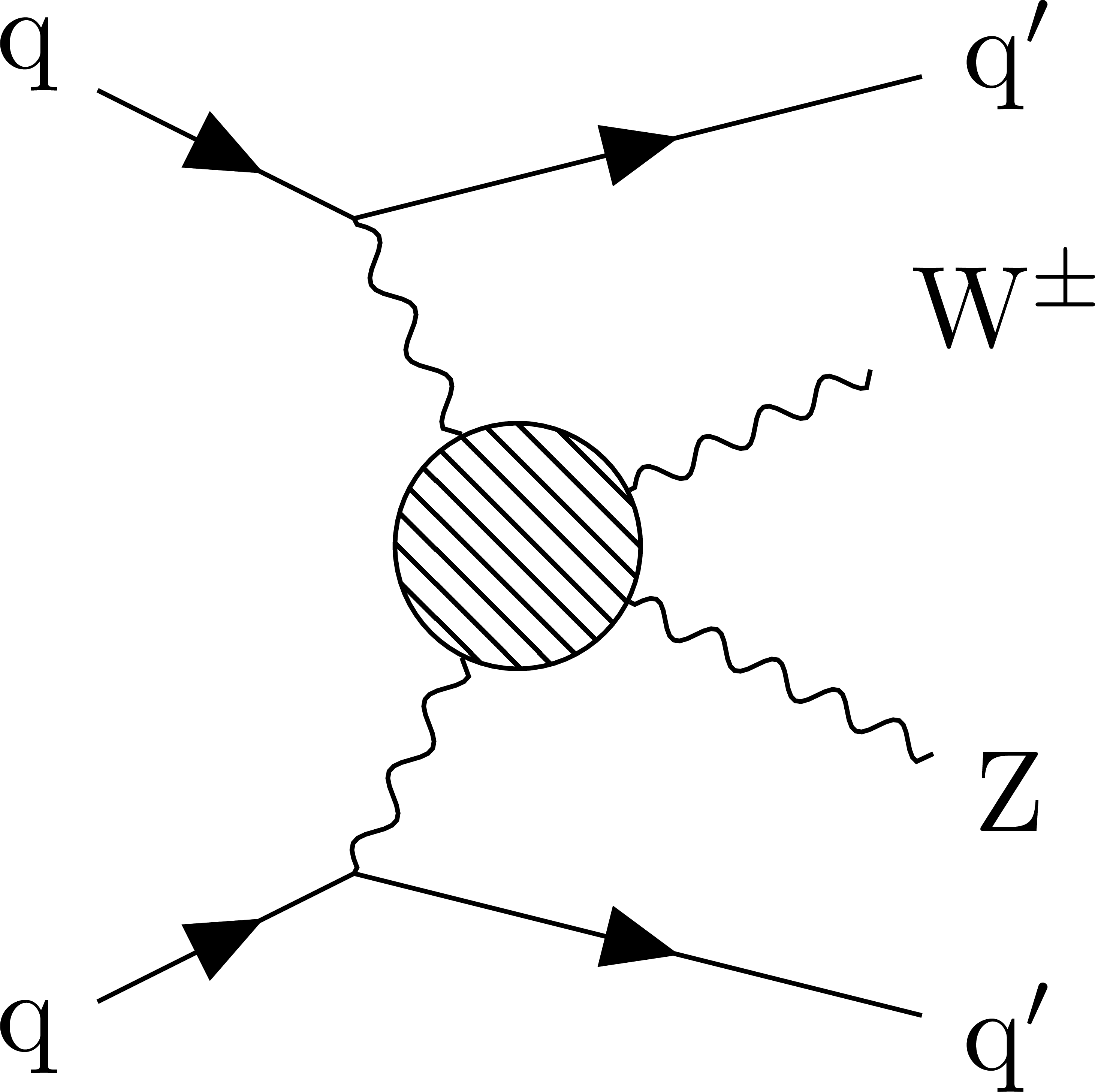
png pdf |
Figure 1-c:
Representative Feynman diagrams for WZjj production in the SM and BSM. EW-induced WZ production includes quartic interactions (a) of the vector bosons. This is distinguishable from QCD-induced production (b) through kinematic variables. New physics in the EW sector modifying the quartic coupling can be parameterized in terms of dimension-eight effective field theory operators (c). Specific models modifying this interaction include those predicting charged Higgs bosons (d). |

png pdf |
Figure 1-d:
Representative Feynman diagrams for WZjj production in the SM and BSM. EW-induced WZ production includes quartic interactions (a) of the vector bosons. This is distinguishable from QCD-induced production (b) through kinematic variables. New physics in the EW sector modifying the quartic coupling can be parameterized in terms of dimension-eight effective field theory operators (c). Specific models modifying this interaction include those predicting charged Higgs bosons (d). |
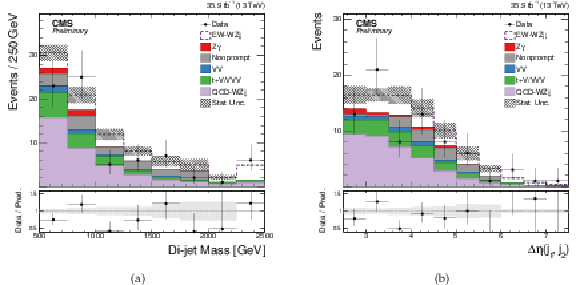
png pdf |
Figure 2:
The distributions of the dijet mass (left) and pseudorapidity separation between the two leading jets (right) for events satisfying the EW signal selection. The last bin also contains all events with dijet mass greater than 2500 GeV (left) and pseudorapidty separation greater than 7.5 (right). The solid symbols represent the number of events measured in data with statistical uncertainties, the stacked filled histograms show different background contributions. The dashed line represents the EW WZ contribution stacked on top of the backgrounds. The bottom panel shows the ratio of the number of events measured in data to the total number of expected events, the shaded band at 1 represents the size of the statistical uncertainties on the predicted yields. Normalizations are shown as values used for the input to the fit. |

png pdf |
Figure 2-a:
The distributions of the dijet mass (left) and pseudorapidity separation between the two leading jets (right) for events satisfying the EW signal selection. The last bin also contains all events with dijet mass greater than 2500 GeV (left) and pseudorapidty separation greater than 7.5 (right). The solid symbols represent the number of events measured in data with statistical uncertainties, the stacked filled histograms show different background contributions. The dashed line represents the EW WZ contribution stacked on top of the backgrounds. The bottom panel shows the ratio of the number of events measured in data to the total number of expected events, the shaded band at 1 represents the size of the statistical uncertainties on the predicted yields. Normalizations are shown as values used for the input to the fit. |
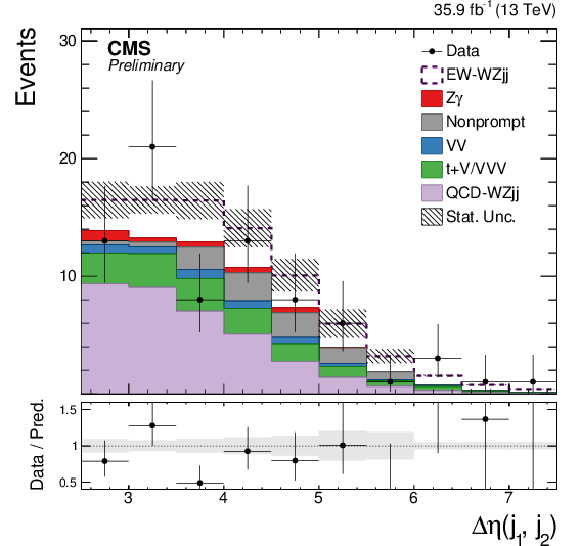
png pdf |
Figure 2-b:
The distributions of the dijet mass (left) and pseudorapidity separation between the two leading jets (right) for events satisfying the EW signal selection. The last bin also contains all events with dijet mass greater than 2500 GeV (left) and pseudorapidty separation greater than 7.5 (right). The solid symbols represent the number of events measured in data with statistical uncertainties, the stacked filled histograms show different background contributions. The dashed line represents the EW WZ contribution stacked on top of the backgrounds. The bottom panel shows the ratio of the number of events measured in data to the total number of expected events, the shaded band at 1 represents the size of the statistical uncertainties on the predicted yields. Normalizations are shown as values used for the input to the fit. |

png pdf |
Figure 3:
The 2D distribution of dijet mass and pseudorapidity separation, used for the EW signal significance extraction. The x-axis shows the dijet mass distribution in the indicated bins, split into three bins of Δηjj: Δηjj∈ [2.5, 4], [4, 5], ≥5. The solid symbols represent the number of events measured in data with statistical uncertainties, the stacked filled histograms show different background contributions. The dashed line represents the EW WZ contribution stacked on top of the backgrounds. The bottom panel shows the ratio of the number of events measured in data to the total number of expected events, the shaded band at 1 represents the size of the systematic uncertainties on the predicted yields. Normalizations are shown as the best fit values. |

png pdf |
Figure 4:
Transverse mass of the WZ system for events satisfying the EW signal selection, used to place constraints on anomalous coupling parameters. The EW WZ contribution, which is treated as background in the fit, is shown as a filled histogram. The dashed lines show predictions for several aQGC parameters values, which include the EW WZ process. Normalizations are shown as the best fit values from the background-only fit. The last bin also contains all events with transverse mass greater than 2000 GeV. Other details as in the caption of Fig. xxxxx. |

png pdf |
Figure 5:
Two-dimensional observed 95% CL limits (solid contour) and expected 68 and 95% CL limits (dashed contour) on the selected aQGC parameters. The values of couplings outside of contours are excluded at the corresponding confidence level. |
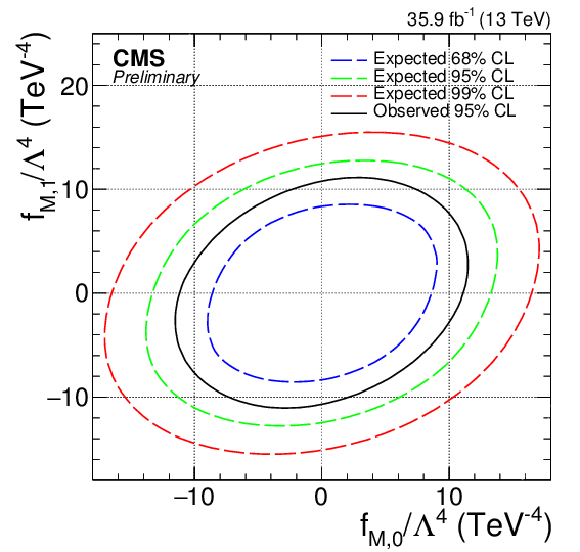
png pdf |
Figure 5-a:
Two-dimensional observed 95% CL limits (solid contour) and expected 68 and 95% CL limits (dashed contour) on the selected aQGC parameters. The values of couplings outside of contours are excluded at the corresponding confidence level. |
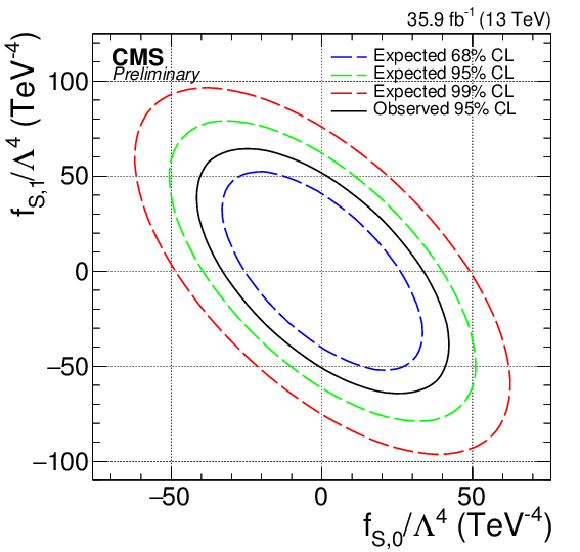
png pdf |
Figure 5-b:
Two-dimensional observed 95% CL limits (solid contour) and expected 68 and 95% CL limits (dashed contour) on the selected aQGC parameters. The values of couplings outside of contours are excluded at the corresponding confidence level. |
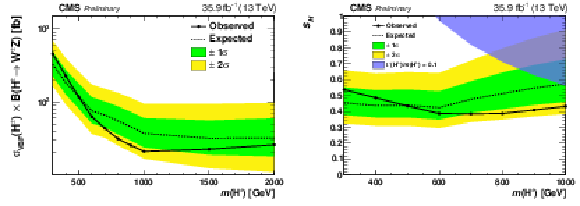
png pdf |
Figure 6:
Expected (dashed lines) and observed (solid lines) exclusion limits at 95% confidence level for the model independent σ(H+)×BR(H+→WZ) as a function of m(H±) (top) and on the vacuum expectation value ratio in the Georgi-Machacek model (bottom). |
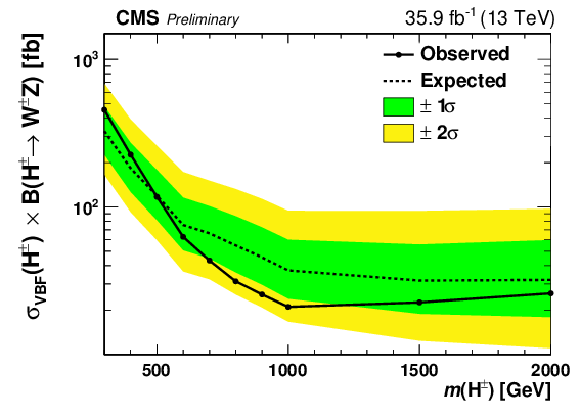
png pdf |
Figure 6-a:
Expected (dashed lines) and observed (solid lines) exclusion limits at 95% confidence level for the model independent σ(H+)×BR(H+→WZ) as a function of m(H±) (top) and on the vacuum expectation value ratio in the Georgi-Machacek model (bottom). |
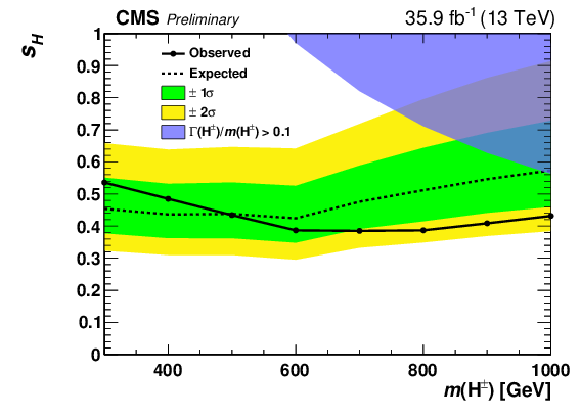
png pdf |
Figure 6-b:
Expected (dashed lines) and observed (solid lines) exclusion limits at 95% confidence level for the model independent σ(H+)×BR(H+→WZ) as a function of m(H±) (top) and on the vacuum expectation value ratio in the Georgi-Machacek model (bottom). |

png pdf |
Figure 7:
The distribution of the dijet invariant mass of the two leading jets for events in the EW signal selection control region. The last bin also contains all events with dijet mass greater than 1900 GeV. The solid symbols represent the number of events measured in data with statistical uncertainties, the stacked filled histograms show different background contributions. The dashed purple line represents the EW WZ contribution stacked on top of the backgrounds. An alternative prediction for the QCD WZ contribution, using MadGraph5\_aMC@NLO with FxFx merging as described in the text of SMP-18-001, is shown in dashed blue. This distribution can be compared to the nominal prediction in filled purple. The bottom panel shows the ratio of the number of events measured in data to the total number of expected events for the nominal QCD WZ prediction. The shaded band at 1 represents the size of the statistical uncertainties on the predicted yields. The hatched blue band shows the sum of Monte Carlo predictions and statistical uncertainties with the alternative QCD WZ prediction divided by the sum of Monte Carlo predictions with the nominal QCD WZ prediction. Normalizations are shown as values used for the input to the fit. |
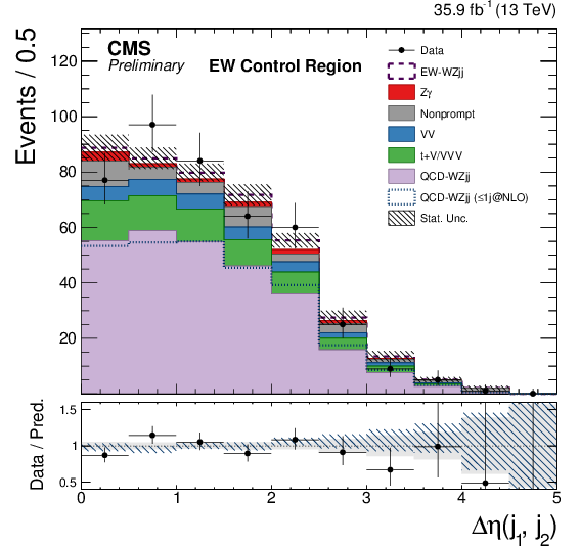
png pdf |
Figure 8:
The distribution of the pseudorapidity separation between the two leading jets for events in the EW signal selection control region. The last bin also contains all events with pseduorapidty separation greater than 5. The solid symbols represent the number of events measured in data with statistical uncertainties, the stacked filled histograms show different background contributions. The dashed purple line represents the EW WZ contribution stacked on top of the backgrounds. An alternative prediction for the QCD WZ contribution, using MadGraph5\_aMC@NLO with FxFx merging as described in the text of SMP-18-001, is shown in dashed blue. This distribution can be compared to the nominal prediction in filled purple. The bottom panel shows the ratio of the number of events measured in data to the total number of expected events for the nominal QCD WZ prediction. The shaded band at 1 represents the size of the statistical uncertainties on the predicted yields. The hatched blue band shows the sum of Monte Carlo predictions and statistical uncertainties with the alternative QCD WZ prediction divided by the sum of Monte Carlo predictions with the nominal QCD WZ prediction. Normalizations are shown as values used for the input to the fit. |
| Tables | |
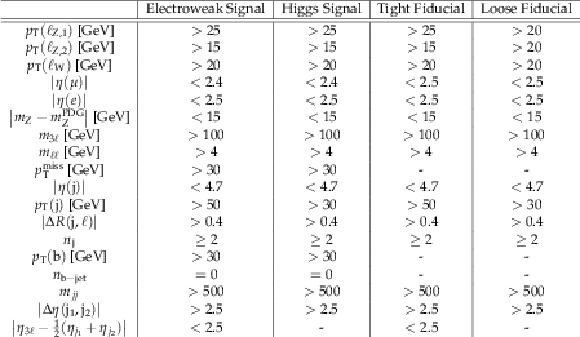
png pdf |
Table 1:
Summary of event selections and fiducial region definitions for the analysis. The selections in the first two columns are applied to data and reconstructed simulated events. The electroweak selection is used for all measurements except for charged Higgs boson studies, which use the selection indicated in the second column. The fiducial selections shown in the last two columns are applied to showered and hadronized events using the R0.8IVET framework [49] or to Born level leptons and partons. The WZjj cross section is reported in the fiducial regions indicated. |

png pdf |
Table 2:
The major uncertainty contributions in the fiducial WZjj cross section measurement and in the measured EW WZ significance. The impact of each systematic uncertainty on the WZjj cross section measurement is obtained by freezing the set of nuisance parameters to their best fit values and comparing the total uncertainty on the signal strength to the result from the nominal fit. The effect on the EW WZ significance, shown in the last column, is defined as the relative increase in the observed significance when removing the nuisance term from the fit. |

png pdf |
Table 3:
Postfit event yields after the signal extraction fit to events satisfying the EW signal selection. |

png pdf |
Table 4:
Observed and expected 95% CL limits for one coupling parameter while all other parameters are set to zero. |
| Summary |
|
A measurement of the production of a W and Z boson in association with two jets was presented, using events where both bosons decay leptonically. Results are based on data corresponding to an integrated luminosity of 35.9 fb−1 recorded in proton-proton collisions at √s= 13 TeV with the CMS detector at the CERN LHC in 2016. The cross section in the fiducial region with enhanced contributions from electroweak WZ production is σfidWZjj= 2.91+0.67−0.60 fb, consistent with the SM prediction. The dijet transverse mass and dijet rapidity separation are used to extract the significance of EW WZ production, which is found to be 1.9 standard deviations with 2.7 expected from the SM prediction. These are the first results for electroweak WZ production at 13 TeV. Constraints are placed on anomalous quartic gauge couplings in terms of dimension-eight effective field theory operators, and upper limits are given on the production cross section times branching fraction of charged Higgs bosons. Results are competitive or more stringent than previous constraints from the WZ channel or from other final states. |
| References | ||||
| 1 | ATLAS Collaboration | Observation of a new particle in the search for the Standard Model Higgs boson with the ATLAS detector at the LHC | PLB 716 (2012) 1 | 1207.7214 |
| 2 | CMS Collaboration | Observation of a new boson at a mass of 125 GeV with the CMS experiment at the LHC | PLB 716 (2012) 30 | CMS-HIG-12-028 1207.7235 |
| 3 | ATLAS Collaboration | Measurement of WZ production in proton-proton collisions at √s= 7 TeV with the ATLAS detector | EPJC 72 (2012) 2173 | 1208.1390 |
| 4 | ATLAS Collaboration | Measurements of W±Z production cross sections in pp collisions at √s= 8 TeV with the ATLAS detector and limits on anomalous gauge boson self-couplings | PRD 93 (2016) 092004 | 1603.02151 |
| 5 | CMS Collaboration | Measurement of the WZ production cross section in pp collisions at √(s)= 13 TeV | PLB 766 (2017) 268 | CMS-SMP-16-002 1607.06943 |
| 6 | CMS Collaboration | Measurement of the WZ production cross section in pp collisions at √s= 7 and 8 TeV and search for anomalous triple gauge couplings at √s= 8 TeV | EPJC 77 (2017) 236 | CMS-SMP-14-014 1609.05721 |
| 7 | R. L. Delgado et al. | Production of vector resonances at the LHC via WZ-scattering: a unitarized EChL analysis | JHEP 11 (2017) 098 | 1707.04580 |
| 8 | W. Kilian, T. Ohl, J. Reuter, and M. Sekulla | Resonances at the LHC beyond the Higgs boson: The scalar/tensor case | PRD 93 (2016) 036004 | 1511.00022 |
| 9 | C. Csaki, C. Grojean, and J. Terning | Alternatives to an Elementary Higgs | Rev. Mod. Phys. 88 (2016) 045001 | 1512.00468 |
| 10 | CMS Collaboration | Description and performance of track and primary-vertex reconstruction with the CMS tracker | JINST 9 (2014) P10009 | CMS-TRK-11-001 1405.6569 |
| 11 | CMS Collaboration | Performance of electron reconstruction and selection with the CMS detector in proton-proton collisions at √s= 8 TeV | JINST 10 (2015) P06005 | CMS-EGM-13-001 1502.02701 |
| 12 | CMS Collaboration | Performance of CMS muon reconstruction in pp collision events at √s= 7 TeV | JINST 7 (2012) P10002 | CMS-MUO-10-004 1206.4071 |
| 13 | CMS Collaboration | The CMS trigger system | JINST 12 (2017) P01020 | CMS-TRG-12-001 1609.02366 |
| 14 | CMS Collaboration | The CMS experiment at the CERN LHC | JINST 3 (2008) S08004 | CMS-00-001 |
| 15 | J. Alwall et al. | The automated computation of tree-level and next-to-leading order differential cross sections, and their matching to parton shower simulations | JHEP 07 (2014) 079 | 1405.0301 |
| 16 | K. Arnold et al. | VBFNLO: A parton level Monte Carlo for processes with electroweak bosons | CPC 180 (2009) 1661 | 0811.4559 |
| 17 | T. Gleisberg et al. | Event generation with \Sherpa 1.1 | JHEP 02 (2009) 007 | 0811.4622 |
| 18 | T. Gleisberg et al. | SHERPA 1.α: A Proof of concept version | JHEP 02 (2004) 056 | hep-ph/0311263 |
| 19 | J. Bendavid et al. | Les Houches 2017: Physics at TeV Colliders Standard Model Working Group Report | 2018 | 1803.07977 |
| 20 | S. Actis et al. | RECOLA: REcursive Computation of One-Loop Amplitudes | CPC 214 (2017) 140 | 1605.01090 |
| 21 | J. Alwall et al. | Comparative study of various algorithms for the merging of parton showers and matrix elements in hadronic collisions | EPJC 53 (2008) 473 | 0706.2569 |
| 22 | Particle Data Group Collaboration | Review of Particle Physics | CPC 40 (2016) 100001 | |
| 23 | CMS Collaboration | Measurement of the associated production of a single top quark and a Z boson in pp collisions at √s= TeV | PLB 779 (2018) 358 | CMS-TOP-16-020 1712.02825 |
| 24 | T. Melia, P. Nason, R. Rontsch, and G. Zanderighi | W+W−, WZ and ZZ production in the POWHEG BOX | JHEP 11 (2011) 078 | 1107.5051 |
| 25 | P. Nason | A new method for combining NLO QCD with shower Monte Carlo algorithms | JHEP 11 (2004) 040 | hep-ph/0409146 |
| 26 | S. Frixione, P. Nason, and C. Oleari | Matching NLO QCD computations with parton shower simulations: the POWHEG method | JHEP 11 (2007) 070 | 0709.2092 |
| 27 | S. Alioli, P. Nason, C. Oleari, and E. Re | A General Framework for Implementing NLO Calculations in Shower Monte Carlo Programs: the POWHEG BOX | JHEP 06 (2010) 043 | 1002.2581 |
| 28 | J. M. Campbell, R. K. Ellis, and C. Williams | Vector boson pair production at the LHC | JHEP 07 (2011) 18 | 1105.0020 |
| 29 | F. Cascioli et al. | ZZ production at hadron colliders in NNLO QCD | PLB 735 (2014) 311 | 1405.2219 |
| 30 | F. Caola, K. Melnikov, R. Rontsch, and L. Tancredi | QCD corrections to ZZ production in gluon fusion at the LHC | PRD 92 (2015) 094028 | 1509.06734 |
| 31 | T. Sjostrand, S. Mrenna, and P. Skands | PYTHIA 6.4 physics and manual | JHEP 05 (2006) 026 | hep-ph/0603175 |
| 32 | T. Sjostrand et al. | An introduction to PYTHIA 8.2 | CPC 191 (2015) 159 | 1410.3012 |
| 33 | CMS Collaboration | Event generator tunes obtained from underlying event and multiparton scattering measurements | EPJC 76 (2016) 155 | CMS-GEN-14-001 1512.00815 |
| 34 | J. Bellm et al. | Herwig 7.0 / Herwig++ 3.0 Release Note | 1512.01178 | |
| 35 | M. Bahr et al. | Herwig++ Physics and Manual | EPJC 58 (2008) 639 | 0803.0883 |
| 36 | NNPDF Collaboration | Parton distributions for the LHC run II | JHEP 04 (2015) 040 | 1410.8849 |
| 37 | GEANT4 Collaboration | GEANT4---a simulation toolkit | NIMA 506 (2003) 250 | |
| 38 | J. Allison et al. | GEANT4 developments and applications | IEEE Trans. Nucl. Sci. 53 (2006) 270 | |
| 39 | CMS Collaboration | Particle-flow reconstruction and global event description with the CMS detector | JINST 12 (2017) P10003 | CMS-PRF-14-001 1706.04965 |
| 40 | M. Cacciari, G. P. Salam, and G. Soyez | The anti-kT jet clustering algorithm | JHEP 04 (2008) 063 | 0802.1189 |
| 41 | M. Cacciari, G. P. Salam, and G. Soyez | FastJet user manual | EPJC 72 (2012) 1896 | 1111.6097 |
| 42 | M. Cacciari, G. P. Salam, and G. Soyez | The anti-kt jet clustering algorithm | JHEP 04 (2008) 063 | 0802.1189 |
| 43 | CMS Collaboration | Determination of jet energy calibration and transverse momentum resolution in CMS | JINST 6 (2011) P11002 | CMS-JME-10-011 1107.4277 |
| 44 | CMS Collaboration | Pileup Jet Identification | CMS-PAS-JME-13-005 | CMS-PAS-JME-13-005 |
| 45 | CMS Collaboration | Identification of b quark jets with the CMS experiment | JINST 8 (2013) P04013 | CMS-BTV-12-001 1211.4462 |
| 46 | CMS Collaboration | Identification of b quark jets at the CMS experiment in the LHC Run 2 | CMS-PAS-BTV-15-001 | CMS-PAS-BTV-15-001 |
| 47 | M. Cacciari and G. P. Salam | Pileup subtraction using jet areas | PLB 659 (2008) 119 | 0707.1378 |
| 48 | CMS Collaboration | Measurement of the inclusive W and Z production cross sections in pp collisions at √s= 7 TeV with the CMS experiment | JHEP 10 (2011) 132 | CMS-EWK-10-005 1107.4789 |
| 49 | A. Buckley et al. | Rivet user manual | CPC 184 (2013) 2803 | 1003.0694 |
| 50 | F. Campanario, M. Kerner, L. D. Ninh, and D. Zeppenfeld | NLO QCD corrections to WZJJ production at the LHC | in Proceedings, 9th Rencontres du Vietnam: Windows on the Universe: Quy Nhon, Vietnam, August 11-17, 2013, p. 201 2013 | 1310.4369 |
| 51 | B. Biedermann, A. Denner, and M. Pellen | Large Electroweak Corrections to Vector-Boson Scattering at the Large Hadron Collider | PRL 118 (2017) 261801 | 1611.02951 |
| 52 | CMS Collaboration | CMS luminosity measurements for the 2016 data taking period | CMS-PAS-LUM-17-001 | CMS-PAS-LUM-17-001 |
| 53 | ATLAS and CMS Collaborations, LHC Higgs Combination Group | Procedure for the LHC higgs boson search combination in Summer 2011 | CMS-NOTE-2011-005 | |
| 54 | T. Junk | Confidence level computation for combining searches with small statistics | NIMA 434 (1999) 435 | hep-ex/9902006 |
| 55 | A. L. Read | Presentation of search results: The CL(s) technique | JPG 28 (2002) 2693 | |
| 56 | G. Cowan, K. Cranmer, E. Gross, and O. Vitells | Asymptotic formulae for likelihood-based tests of new physics | EPJC 71 (2011) 1554 | 1007.1727 |
| 57 | C. Degrande et al. | Effective field theory: A modern approach to anomalous couplings | Annals Phys. 335 (2013) 21 | 1205.4231 |
| 58 | O. J. P. \'Eboli, M. C. Gonzalez-Garcia, and J. K. Mizukoshi | pp→jje±μ±νν and jje±μ∓νν at O(α6em) and O(α4emα2s) for the study of the quartic electroweak gauge boson vertex at CERN LHC | PRD 74 (2006) 073005 | hep-ph/0606118 |
| 59 | T. Junk | Confidence level computation for combining searches with small statistics | NIMA 434 (1999) 435 | |
| 60 | A. L. Read | Presentation of search results: the CLs technique | JPG: Nucl. Part. Phys. 28 (2002) 2693 | |
| 61 | G. Belanger and F. Boudjema | Probing quartic couplings of weak bosons through three vectors production at a 500-GeV NLC | PLB 288 (1992) 201 | |
| 62 | H. Georgi and M. Machacek | Doubly charged Higgs bosons | NPB 262 (1985) 463 | |
| 63 | M. Zaro and H. Logan | Recommendations for the interpretation of LHC searches for H05, H±5, and H±±5 in vector boson fusion with decays to vector boson pairs | LHCHXSWG-2015-001 | |

|
Compact Muon Solenoid LHC, CERN |

|

|

|

|

|

|